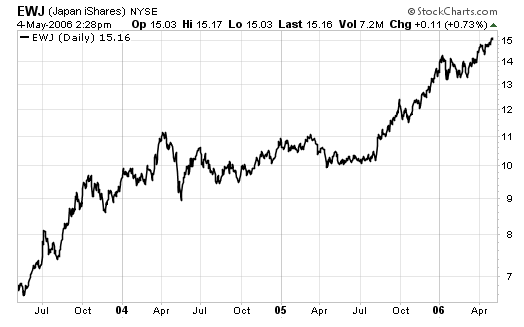| Home | About Us | Resources | Archive | Free Reports | Market Window |
The Future of American GasolineBy
Friday, May 5, 2006
Henry Ford was almost a century ahead of his time... Ford’s design for the original Model T in 1908 called for the engine to run on a special form of alcohol, a substance called ethanol. After all, ethanol comes from corn – a plentiful resource. It’s safe and renewable. Ford, however, didn’t end up using alcohol. He found it less costly to go with leaded gasoline. This was a blend of gasoline and tetraethyl lead - a fuel additive that made engines run more efficiently. The thing is, lead is nasty stuff... overexposure causes blindness, kidney failure and cancer. Workers in lead production were poisoned. So by 1979, the perils of tetraethyl lead caught up with it and its use was banned. A new additive, and the first “new gasoline” was found to replace leaded gas. The new additive was MTBE (methyl tert-butyl ether). MTBE was hailed as a cleaner, safer alternative to tetraethyl lead. Folks thought it was a silver bullet. It helped engines run smoother, and it burned clean as a whistle. The new gasoline burned so clean, it reduced airborne pollution, and some gasoline was “reformulated” with twice the MTBE content as regular gasoline. If a little was good, double was better. Gas with MTBE quickly took over as the “new” new gas, and air pollution-prone cities, like Denver and LA, soon required the use of it. Today, we use 200,000 barrels of MTBE per day... Problem is, MTBE isn’t as safe as we thought... America recently discovered that MTBE leaks into the nation’s water supply, potentially causing major health problems and therefore requiring complicated treatment at taxpayers’ expense. There was so much MTBE in groundwater by the 1980s that legislators decided to do something. By 2004, six states outlawed the use of MTBE. As of today – May 5, 2006 – every gas company in the nation, all the way from the tiny mom and pop station down the street to the biggest of the Big Oil companies, must replace the MTBE in their fuel lines with ethanol, or they face serious litigation. This changeover is arguably the biggest shift in American energy policy of the past 27 years. A shift that’s taking place today, May 5, 2006. If it were up to Big Oil, they wouldn’t change a thing. This "switch" could cost them an additional $25-$80 billion dollars over the next 12 months. But this mandate comes directly from the U.S. Congress and President Bush himself... There are a handful of reasons for this mandate. But the biggest one is this: Gas burns cleaner with ethanol added — it’s more environmentally friendly. The deadline has Big Oil scrambling to install ethanol-infrastructure in their refineries, and to buy up as much ethanol as they can get their hands on. This frenzy is not only causing a boom in the price of ethanol, but a construction boom as well... Right now, there are 97 ethanol plants in the United States. That number should double in the next few years. Over 30 plants are currently under construction. There are plans for another 150 new plants and extensions. You see, according to Section 1501 of last summer’s Energy Policy Act, America has to use “7.5 billion gallons of ethanol and biodiesel annually by 2012 — a nearly 90 percent increase over today’s usage.” That’s a guaranteed long-term market for ethanol. For most investors, the obvious way to take advantage of this trend is Archer Daniels Midland (ADM). This $23 billion agricultural giant is the largest domestic producer. It’s like the ExxonMobil of ethanol. This company is up 46% so far this year, with some room left for growth. But ethanol makes up only 6% of its total sales, which makes it a very indirect way to invest in ethanol. The key for investors who are interested in this opportunity is to get as much exposure to ethanol as possible. There are a few options out there. While ethanol may just be a short-term fix to a long-term energy problem that’s only intensifying in its severity, ethanol is, at least for the next 6 years, here to stay. Good investing, Matt Badiali Market NotesNOT AT ALL TIME HIGHS… BUT HEADED IN THE RIGHT DIRECTION This week, Asian stocks as a whole hit their highest levels in 17 years… The rally looks frothy at the moment. The stock markets of Taiwan, Singapore, Vietnam, Indonesia, and India haven’t taken a breather in months. Stocks in Singapore and India are at the highest levels in history. Japan is the big exception… Japanese stocks have enjoyed the Asian rally of the past few years, surging 125% since April 2003. But unlike its neighbors, Japan’s stock market had to shake off one of the most brutal equity bear markets ever recorded. It lasted 13 years and took the Nikkei from 39,000 all the way down to 7,600. Even after the recent rebound, Japanese stocks are still trading at levels less than half of what they reached in 1989. We should point out that Steve Sjuggerud recognized the value in Japanese stocks long before most others. As he likes to say: “The easy money is made when things go from bad to less bad.” True Wealth readers are now sitting on a 35% gain, generated in less than one year… Japan: Finally recovering from a 13-year bear market (3-year chart):
-Brian Hunt |
Recent Articles
|


